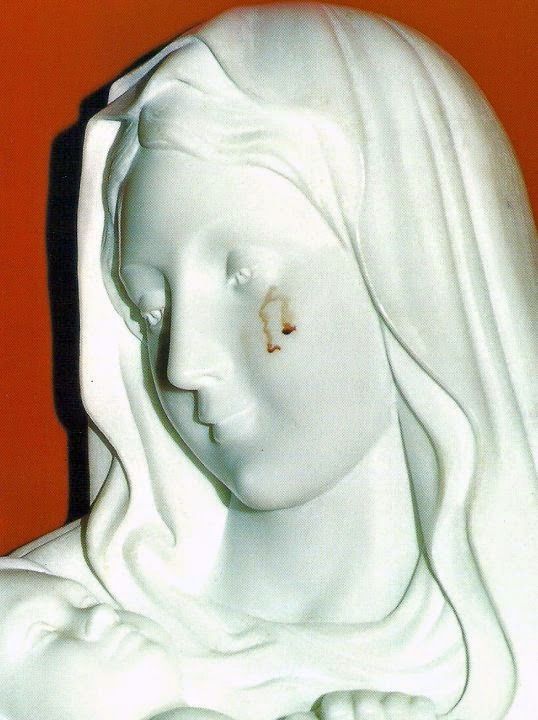
In this article, we shall discuss a small number of purported miracles that have occurred for many years, and presently continue to occur, most especially in front of great crowds of spectators at Christian churches, cathedrals, and shrines. Among the Christian Orthodox peoples, there is the phenomenon known as “The Blue Flame” or “The Blue Fire” or as “Holy Fire”. In Jerusalem, Israel at the Church of the Holy Sepulchre, the Holy Fire ritual is performed which symbolizes, during Easter Season, attended by many thousands of observers, the resurrection of Jesus Christ. In the Church of the Holy Sepulcher is an ancient tomb believed to be the actual tomb of Jesus Christ, before he allegedly rose from the dead.
The Greek Patriarch of Jerusalem descends alone into the empty Ericule; a small shrine within the Holy Sepulcher that surrounds the tomb. Before his arrival. the tomb is inspected for lighting equipment, and the doors are sealed with beeswax, and a cloth lash. After entering the tomb, the Patriarch kneels, then prays. Sunbeams that pierce through a skylight in the church’s dome are believed by the faithful to ignite a flame deep inside the crypt. This divine flame is a mysterious Godly creation considered a Holy Saturday miracle each year before Orthodox Easter Sunday. The miraculous flame, is usually blueish and rises vertically from a marble slab that is believed to be the former resting place of Jesus Christ. The Patriarch then uses the sacred flame to light thirty three beeswax candles; thirty three represents the number of years of Jesus Christ on earth.
The Patriarch emerges from the tomb with the brightly burning candles in his hands. The lighted candles are used to light unlit candles which causes a great blaze of heat and light. Believers claim that for the first few moments after the sacred fire emerges from the tomb that the flame does not consume (like in story of Moses and the burning bush that was not consumed). Hence, many of the devotees of the practice “bathe” their hands and faces in the fire to perform some type of “ritual cleansing”. The ceremony of The Holy Fire is at least 1,200 years old.
Miraculous weeping statues and paintings. Such mysterious Christian phenomena has occurred for centuries. Of course there are many cases of such seemingly supernatural weeping holy statues and holy paintings, but we shall talk about those sacred artwork that are believed to weep even in the present. Weeping statues- since 1997 till present in Platina, Brazil, a statue of Our Lady of the Sacred Heart, sheds a red liquid, believed to be blood, but is unverified.

In another instance, in January 2006 till present, in Borg in Nadur, Birzebbuga. Malta, tears of what is believed to be blood, flow and, at times, the appearance of oil and salt, but unverified self published claims also about other weeping statues. In regards to trickery, liquids can be injected into the porous material of statues, and then later seep out to produce “tears”. Oil that is mixed with fat can be applied to a statue’s eyes, that shall “weep” when comfortable temperatures very much rise in the church, cathedral, or chapel. Also, tears that statues appear to weep can be beads of condensation from the statue being made from a material of varying density, with condensation forming on the denser (colder) pieces. as in the eyes.
Of course there are many other ways to produce a weeping hoax. Weeping paintings or weeping icons of The Virgin Mary, Mother of Jesus Christ have occurred. But, to date, not a single case of a weeping painting; icon has been officially sanctioned by either the Roman Catholic Church or by the Coptic Church. The most recent case of a weeping holy Mary Painting seems to be at the former Holy Trinity Greek Orthodox Church formerly at the Northwest section of Chicago, Illinois. The mysterious event occurred on September 10, 2019, shortly before the church was sold by bankruptcy court hearings to Universal Church for $2.5 Million Dollars, that also includes a school building that the Chicago Public Schools rented.

The “crying” Holy Mary Painting has red tears that appear to be blood or blood like. Big crowds of people have seen the weeping painting with the bloody liquid from the eyes. The tears were believed by a great many folks to be a sign from the Holy Mother of Jesus Christ to express great sorrow over the mortgage foreclosure of the church, and the need for the laity and congregation to relocate to some other building to be used for a new church. We shall now discuss the case of an ancient Christian martyr whose blood, in a small quantity, was gathered up, then placed in a container. This dried blood, on special occasions, liquified, thus becomes a miracle to the Christian believers. In Naples, Italy, at Naples Cathedral, the blood of the martyr, Saint Januarius , also known of Januarius I of Benevento, was a Bishop born in the third century, and then died in circa 305 AD. A small amount of his blood was collected, upon his death, during the Roman Emperor’s persecution of Christian’s that lasted one and a half years. That Roman emperor is believed to have been Gaius Aurelius Valerius Diocletianus (commonly known simply as Diocletian) who was the emperor from 284 AD to 305 AD. The blood of Saint Januarius is stored in two small containers, that were hermetically sealed, called ampolues, held since the 17th century in a silver reliquary between two glass plates about twelve cm wide. Separate reliquaries have bone fragments inside that are believed to be of Saint Januarius. There are times when the blood of Saint Januarius turned from solid to liquid, pantyhose events were considered as miracles among the faithful.

Thousands of people come to Naples Cathedral three times a year: on September 19 (that commemorates his martyrdom), December 16 (honors his patronage of Naples and its archdiocese), and on the Saturday before the first Sunday of May (commemorating the reunification of the saint’s relics). Naples also has blood liquification “miracles” of the stored blood in vials of Saint Patricia and Saint John The Baptist in the monastery of San Gregorio Armeno, and the blood stored of Saint Pantaleon in Ravello.
Over the many years, crowds of people saw the liquified blood of these saints. Critics, skeptics, for many, many years have mentioned how there can be fraud techniques employed to create these so-called miracles. But, there are a very great many believers in the Christian world who choose to believe these fascinating, mysterious events are really miracles.


